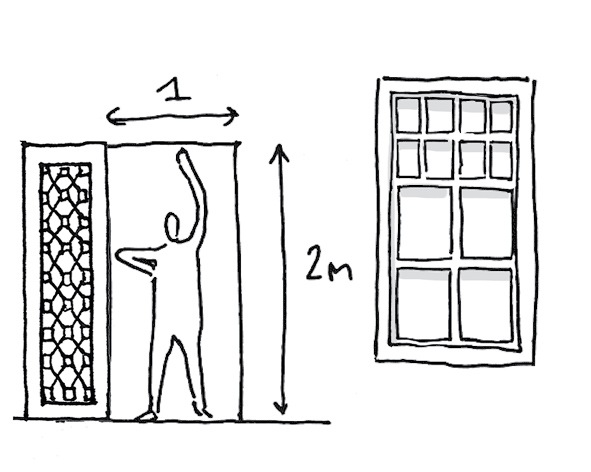15.2. Human-Scale Detail
Aus Pattern Language Wiki
Within the construction process of Design-Build Adaptation, create elements that will reflect the scale of human beings.
Problem-statement: People need to see their own human scale reflected throughout the environment. This is true at close distances and at long distances as well.
Discussion: At close distances, the incorporation of human-scale detail is obvious. We must simply create elements that are the size of human beings or smaller, and easily relatable by human beings: doorways, windows, door handles, and other details. At longer distances, the challenge is greater. It is necessary to use forms that are clearly human-scaled. For example, a window that is approximately 1 meter wide and 2 meters high (roughly 3 feet by 6 feet), extending up from the ground to upper levels of a building, will readily convey a human scale.
The human scales range from 2 m down to ¼ mm, covering the height of a person to the thickness of an eyelash. Our evolution has programmed us to seek out those scales, and discern their interrelationships, in order to navigate and decide upon features in our environment. We subconsciously treat artificial structures in the same way, looking for the human scales at varying distances. If the built environment shows fractal scaling, just like the natural environment, it will include those human scales.¹ Then we feel more “at home” and can concentrate on perceiving attractions or threats directly. If the human range of scales is missing, however, then we cannot feel comfortable in our environments.
Therefore:
Create a generous number of elements that are human-scale, i.e. 1 meter by 2 meters or less. Make sure that many of these elements are structures that people are physically familiar with, e.g. roughly human-proportioned windows, hand-crafted patterns, etc.
Use Construction Ornament and Complex Materials to enrich the human scale. …
¹ See more at Salingaros, N. A. (1999). Architecture, Patterns, and Mathematics. Nexus Network Journal, 1(1-2), 75-86.
Mehaffy, M. et al. (2020). HUMAN-SCALE DETAIL (pattern). In A New Pattern Language for Growing Regions. The Dalles: Sustasis Press. Available at https://pattern-language.wiki/.../Human-Scale_Detail
SECTION I:
PATTERNS OF SCALE
1. REGIONAL PATTERNS
Define the large-scale spatial organization…
1.4. 400M THROUGH STREET NETWORK
2. URBAN PATTERNS
Establish essential urban characteristics…
3. STREET PATTERNS
Identify and allocate street types…
4. NEIGHBORHOOD PATTERNS
Define neighborhood-scale elements…
5. SPECIAL USE PATTERNS
Integrate unique urban elements with care…
6. PUBLIC SPACE PATTERNS
Establish the character of the crucial public realm…
7. BLOCK AND PLOT PATTERNS
Lay out the detailed structure of property lines…
8. STREETSCAPE PATTERNS
Configure the street as a welcoming place…
9. BUILDING PATTERNS
Lay out appropriate urban buildings…
10. BUILDING EDGE PATTERNS
Create interior and exterior connectivity…
10.1. INDOOR-OUTDOOR AMBIGUITY
SECTION II:
PATTERNS OF MULTIPLE SCALE
11. GEOMETRIC PATTERNS
Build in coherent geometries at all scales…
11.2. SMALL GROUPS OF ELEMENTS
12. AFFORDANCE PATTERNS
Build in user capacity to shape the environment…
13. RETROFIT PATTERNS
Revitalize and improve existing urban assets …
14. INFORMAL GROWTH PATTERNS
Accommodate “bottom-up” urban growth…
15. CONSTRUCTION PATTERNS
Use the building process to enrich the result…
SECTION III:
PATTERNS OF PROCESS
16. IMPLEMENTATION TOOL PATTERNS
Use tools to achieve successful results…
16.2. ENTITLEMENT STREAMLINING
16.3. NEIGHBORHOOD PLANNING CENTER
17. PROJECT ECONOMICS PATTERNS
Create flows of money that support urban quality…
17.4. ECONOMIES OF PLACE AND DIFFERENTIATION
18. PLACE GOVERNANCE PATTERNS
Processes for making and managing places…
18.3. PUBLIC-PRIVATE PLACE MANAGEMENT
19. AFFORDABILITY PATTERNS
Build in affordability for all incomes…
19.1. INTEGRATED AFFORDABILITY
20. NEW TECHNOLOGY PATTERNS
Integrate new systems without damaging old ones…
20.2. RESPONSIVE TRANSPORTATION NETWORK COMPANY


